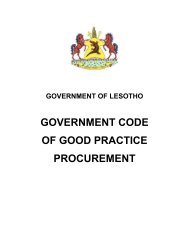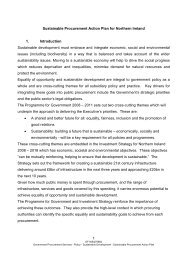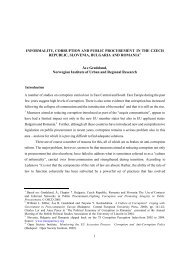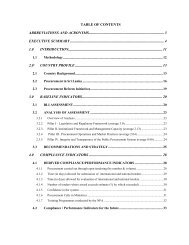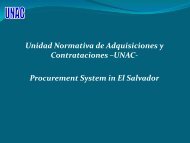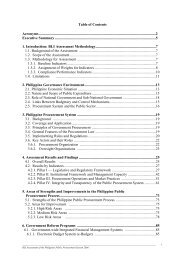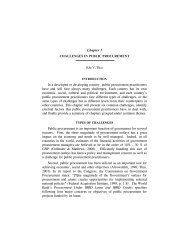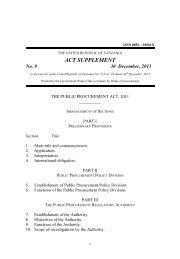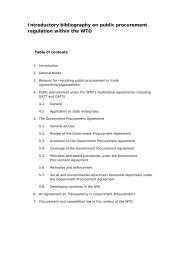Compendium of Country Examples and Lessons Learned from ...
Compendium of Country Examples and Lessons Learned from ...
Compendium of Country Examples and Lessons Learned from ...
Create successful ePaper yourself
Turn your PDF publications into a flip-book with our unique Google optimized e-Paper software.
The Procurement Assessment Methodology:A Tool to Increase the Effectiveness <strong>of</strong> the Use <strong>of</strong> Public FundsIncreasing effectiveness, efficiency <strong>and</strong> transparency <strong>of</strong> public procurement systems is an on-goingconcern <strong>of</strong> governments <strong>and</strong> <strong>of</strong> the international development community. For public funding(including funds provided through <strong>of</strong>ficial development assistance) to be use to the best effect, it isnecessary to have a national procurement system that meets international st<strong>and</strong>ards <strong>and</strong> that operatesas intended.The Methodology is intended to provide a common tool, which developing countries <strong>and</strong> donors canuse to assess the quality <strong>and</strong> effectiveness <strong>of</strong> national procurement systems. The underst<strong>and</strong>ing is that:The assessment will provide an analysis <strong>of</strong> the strengths <strong>and</strong> weaknesses <strong>of</strong> the system <strong>and</strong> abasis upon which a country can formulate a capacity development plan to improve itsprocurement system;Donors can use the common assessment to develop strategies for assisting the capacitydevelopment plan <strong>and</strong> to mitigate risks in the individual operations that they decide t<strong>of</strong>und; <strong>and</strong>In the long term, countries will improve their national procurement systems to meetinternationally recognised st<strong>and</strong>ards enabling greater effectiveness in the use <strong>of</strong> funds tomeet country obligations.The Methodology‟s core objective is capacity development <strong>and</strong> progress is dependent upon countryownership <strong>and</strong> commitment to implement the capacity development programme. It was agreed withthe Joint Venture on Monitoring the Paris Declaration that the procurement baseline indicators wouldbe used to help monitor the qualitative procurement target <strong>of</strong> the Paris Declaration (Target 2b). 5The Methodology follows a two-step approach. Part I covers the baseline indicators (BLIs) that dealwith the formal <strong>and</strong> functional features <strong>of</strong> the existing system, while Part II covers thecompliance/performance indicators (CPIs) that deal with monitoring performance data to determinethe level <strong>of</strong> compliance with the formal system. The application <strong>of</strong> the BLIs is based on a review <strong>of</strong>the existing regulatory framework <strong>and</strong> the institutional <strong>and</strong> operational arrangements including themarketplace. The application <strong>of</strong> the CPIs relies on data obtained <strong>from</strong> a representative sample <strong>of</strong>contracts <strong>and</strong> information obtained <strong>from</strong> surveys or questionnaires with stakeholders <strong>of</strong> theprocurement system. Since data <strong>and</strong> information for the CPIs may not be available, the extent <strong>of</strong>application <strong>of</strong> the CPIs is to be decided at the country level between the government <strong>and</strong> interesteddevelopment partners. A list <strong>of</strong> suggested compliance/performance indicators is given in Part II <strong>of</strong> the5Indicator 2, Reliable country systems: number <strong>of</strong> partner countries that have procurement <strong>and</strong> publicfinancial management systems that either a) adhere to broadly accepted good practices or b) have areform programme in place to achieve these. Target for 2(b) Procurement: one-third <strong>of</strong> partnercountries move up at least one measure (i.e. <strong>from</strong> D to C, C to B or B to A on the four-point scaleused to assess performance for this indicator).COMPENDIUM OF COUNTRY EXAMPLES AND LESSONS LEARNED […] - OECD 2008 11



